Further Adventures on the Cornish Coast
Our Celtic Spirituality Morning gave way to lunch at The Cook Book in St Just. Once a bookshop/café, now it’s a café with books for décor. I ordered a plated salad after it was explained to me that a plated salad is salad on a plate. I had an image of latticed and braided vegetables but it was just a salad—a good one—with about a pound of cheese on the side. I ate one hunk and we put the rest in an omelette in the evening. In conception an omelette but one that turned into scrambled eggs as mine so often do.
On the way back to Morvah I announced I was going to take a nap the minute we got home.
“You have to bring in the washing first, “Sue said.
We all brought in the washing and we all had a rest before the omelette cum scrambled egg and frozen potato waffle, which are like French fries (chips) only waffled. We had a time figuring out the broiler for the waffles. I dropped out early and went for Alec who wasn’t home.
“He won’t know. He’ll just come in and tell us it isn’t working.” Sue again.
Someone (not me) found the right buttons in the right order to get the thing to heat.
Finally we set off for the Minack Theatre where I would be collecting on part of this year’s birthday present, the other part being the most gorgeous box of artisanal chocolates I had ever seen. The Minack is an open air theater built into the Cornish cliffs and looking onto the Atlantic Ocean. It was built by Rowena Cade in the early thirties. For two years, she and her gardener moved granite boulders and earth from the cliffs below her garden to create terraces. Since then it has become a celebrated setting for plays, recitals and entertainment of all kinds.
The play we saw, Stones in His Pocket by Marie Jones uses two actors to play all the characters. They moved quickly from one character to another by use of a gesture, a turn or in the most obvious of cases –to everyone but me—switching between blue and a red cap. Wendy was later incredulous that I had missed the significance of the red and blue caps as (apparently) the entire plot hinged on them.
In my defense I must say that the setting of The Minack was distracting. Sitting on the headlands on the edge of the sea, I watched the waves and gulls and the sinking of the sun into west, muting the edge of sea and sky until everything was dark except for the stars and of course the stage lights, which didn’t seem all that out of place. With all the external drama, my wandered in and out of the play.
We were bundled up though it was a mild night for mid-September. A group of young German women, in their late teens, sat in front of us. Before the play started we saw that one of them was crying and her companions were rubbing her arms and talking earnestly to her.
Suddenly Wendy up and offered them one of our blankets. “Is your friend cold? Would you like a blanket? We can share.”
I thought, “Wait a mo’. I don’t want to be cold.” In truth I was positively sweating with four layers on top and two pairs of socks, a scarf, a hood and a blanket , which I felt compelled to share with Wendy as the price of sitting next to someone so thoughtful. She also got half of Sue’s blanket so for her kindness she got double warmth. Quite right.
When the subject of the young women came up on the way home, Sue said “She probably cries all the time and whines about everything and they’ve figured out how to humor her,” which made me burst out laughing.
An enormous harvest moon guided us home and a tailgater lit us up from behind.
The next morning Sue popped her head round my door to say, “Oh Elena, you’ll want long pants. There are stinging nettles” and I had that sense of being a seven year old with my parents. We were to walk the cliff path that begins with the public footpath next to the church and hooks up with the Cornish Coastal path. The rugged coastal path extends from Minehead up in Somerset all the way around Cornwall to Poole in Dorset. Parts of it are easy but parts have huge boulders to negotiate and an unforgiving rocky path. Wendy has walked a good deal of the coastal path. Her assessment of our little bit was that it was of middling difficulty.
I told Wendy and Sue about my nurse friend Susan who looked me straight in the eye and said “DON’T FALL.” We laughed about it but there was method. I didn’t lark about on the cliffs and I walked carefully on the paths and over the boulders, her words in my mind.
We were working our way along when into the beauty of the stark blue sky and the rugged black headlands strode a man wearing nothing but hiking boots and briefs. Brief briefs. Practically a cod piece. He paraded past us at the intersection of the foot path and the coastal path. Before we’d recovered our surprise another man came into view from the north.
“Here’s another one,” Sue said. “This one has clothes on.”
The second man passed us chuckling.
We walked a different piece of the trail when we visited Zennor and this became my favorite walk. My poetry for this trip was Rilke’s Duino Elegies. I never got past the first elegy and I puzzled over the words. Standing near Zennor Head watching the dark of the sea burst into white spray against the black rocks, astonished by the colors in the carpet of wildflowers and gorse, hearing the fierce wind, feeling the warm sun, I thought I understood Rilke’s words:
Beauty is nothing but
The beginning of terror, that we are still able to bear
And revere it so, because it calmly disdains to destroy us.
 RSS Feed
RSS Feed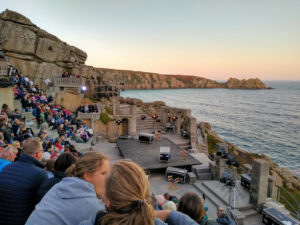
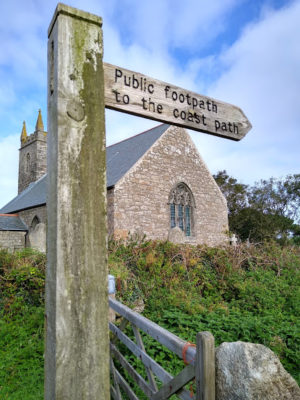
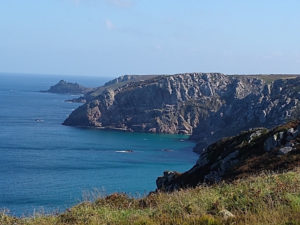
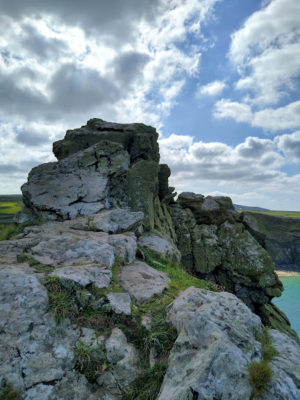
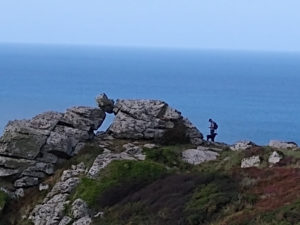
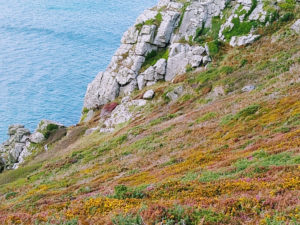
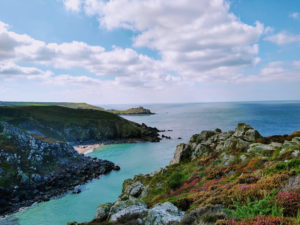
Beautifully descriptive. I knew what it looked like before I even saw the photos.
We ran into a group of 25 coasteers in Wales, wearing matching shirts. Apparently it’s like mountaineering, but they go coasteering along as many coastal paths as they can, many of which are quite challenging. Maybe some of them just wear brief briefs rather than t-shirts.
Your pictures are beautiful! Well done!
Your blog post was fun as always to read, as it is very personal and makes me feel like I am along for the trip. Your pictures are very good, and that theater on the edge of the water is really quite astounding.